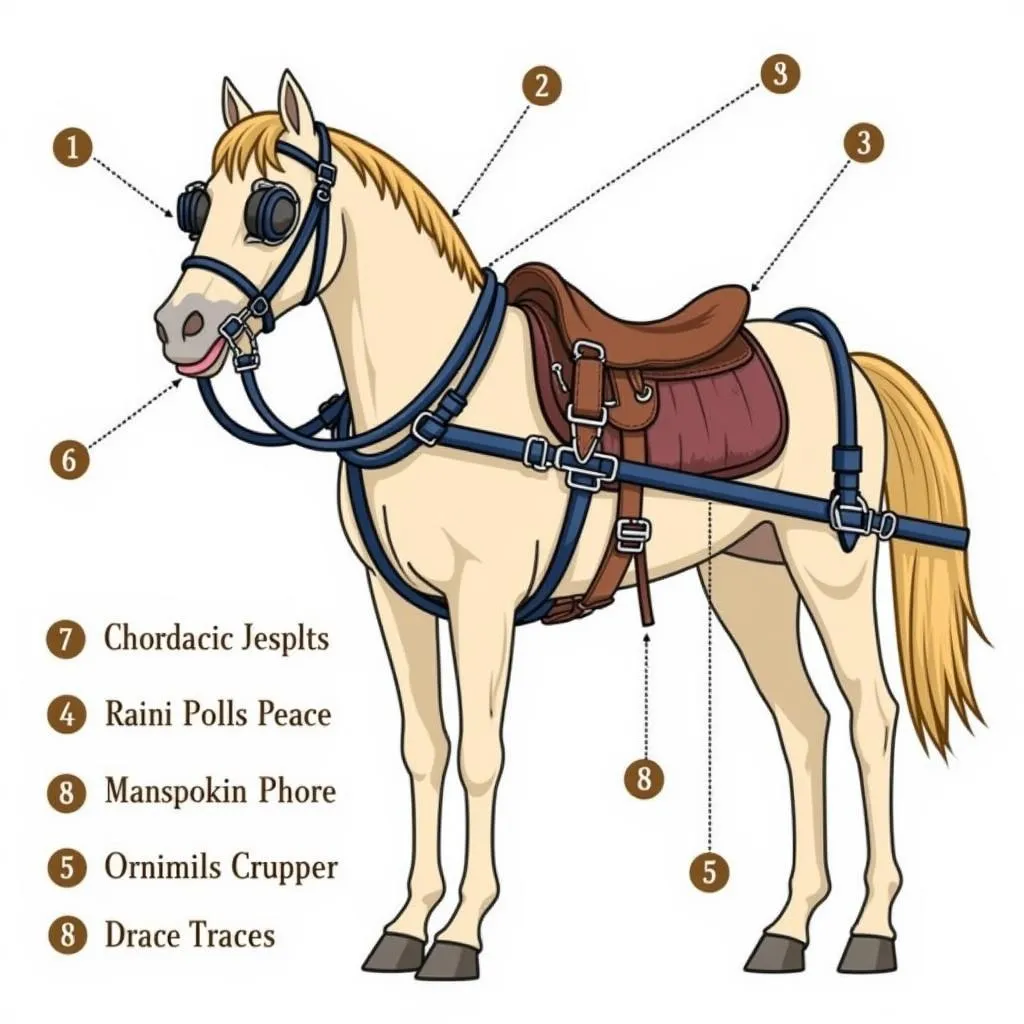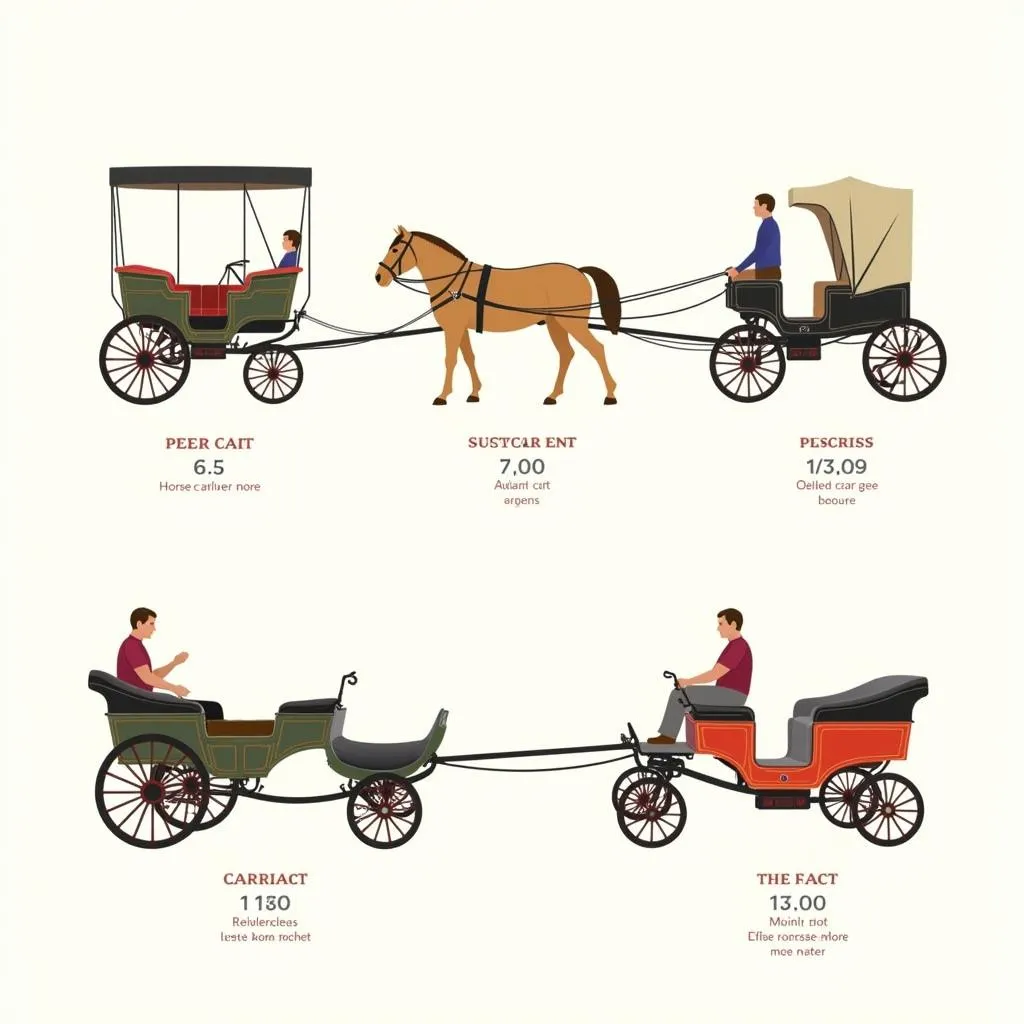Driving horses is a rewarding and enjoyable experience, requiring specialized equipment to ensure both the horse’s and driver’s safety and comfort. This comprehensive guide explores the essential Driving Equipment For Horses, from harnesses to carriages, offering insights into their functions and importance.
Understanding the Basics of Driving Equipment for Horses
Before delving into specifics, it’s crucial to grasp the fundamental purpose of driving equipment. Unlike riding, where the rider’s aids control the horse, driving relies on a system of harnesses and reins to communicate with the horse and guide its movements. This equipment must be durable, well-fitted, and properly adjusted to ensure the horse’s well-being and optimal performance.
 Horse Driving Harness Components
Horse Driving Harness Components
Horse Driving Harnesses: The Core of Driving Equipment
The driving harness is the most critical piece of equipment, acting as the interface between horse and carriage. It distributes the load evenly across the horse’s body, allowing it to pull the carriage comfortably and efficiently.
Types of Horse Driving Harnesses
Various harness types cater to different driving disciplines and horse conformations. Common types include:
- Breastcollar Harness: Ideal for lighter work and less experienced horses, distributing pulling force primarily across the chest.
- Collar and Hames Harness: Suitable for heavier loads and experienced horses, utilizing a padded collar and hames to distribute pulling force over the shoulders and chest.
Key Components of a Horse Driving Harness
A typical harness comprises several components, each serving a specific purpose:
- Bridle: Similar to a riding bridle, it includes a headstall, bit, and reins for communication and control.
- Breastcollar or Collar and Hames: Distributes pulling force from the carriage to the horse.
- Saddle: Provides a stable platform for the traces and holds the breeching in place.
- Breeching: Prevents the carriage from pushing into the horse during deceleration or downhill movement.
- Traces: Connect the harness to the carriage, transmitting the pulling force.
 Horse Wearing a Properly Adjusted Harness
Horse Wearing a Properly Adjusted Harness
Choosing the Right Driving Harness
Selecting the appropriate harness is crucial for the horse’s comfort and performance. Factors to consider include:
- Horse’s Size and Conformation: The harness should fit snugly without restricting movement or causing discomfort.
- Driving Discipline: Different disciplines require specific harness types, such as a lighter harness for pleasure driving or a sturdier one for competition.
- Experience Level: Less experienced horses benefit from simpler harnesses, while more seasoned horses may require specialized features.
Driving Bits and Reins: Communication and Control
The bit and reins are essential for communication and control while driving.
Types of Driving Bits
Driving bits differ from riding bits, designed for leverage and control rather than subtle cues. Common types include:
- Liverpool Bit: A versatile bit with varying leverage depending on rein position.
- Wilson Bit: A milder bit suitable for sensitive horses.
- Elbow Bit: Provides significant leverage, typically used for experienced horses requiring precise control.
Driving Reins: Maintaining Connection
Driving reins are typically longer than riding reins, allowing for communication and adjustments from a distance. Leather is the preferred material for its durability and grip.
Carriages and Vehicles: Selecting the Right Fit
The carriage or vehicle is equally crucial as the harness, playing a significant role in the overall driving experience.
Types of Horse-Drawn Carriages
Various carriage types cater to different purposes and driving disciplines:
- Pleasure Carts: Lightweight and easy to maneuver, perfect for recreational driving.
- Road Carts: Designed for longer distances and smoother roads, offering more comfort.
- Show Carriages: Elaborately designed for competitions and exhibitions, showcasing elegance and style.
Choosing the Right Carriage
Consider these factors when selecting a carriage:
- Intended Use: Pleasure driving, competition, or specific disciplines influence carriage choice.
- Number of Horses: Carriages are designed for single, pair, or multiple horse teams.
- Terrain and Conditions: Choose a carriage suitable for the intended driving environment.
 Various Types of Horse-Drawn Carriages
Various Types of Horse-Drawn Carriages
Essential Accessories for Horse Driving
Several accessories enhance safety and convenience while driving:
- Whips and Driving Crops: Used for encouragement and reinforcement, not punishment.
- Driving Gloves: Protect hands from blisters and provide a better grip on the reins.
- Safety Equipment: Reflective gear, helmets, and safety harnesses are essential for road driving.
Maintaining Driving Equipment for Horses
Regular inspection and maintenance of driving equipment are crucial for safety and longevity:
- Clean and Condition: Regularly clean and condition leather harnesses and reins to prevent cracking and maintain suppleness.
- Inspect for Wear and Tear: Check for signs of wear, such as frayed stitching or cracked leather, and replace damaged parts promptly.
- Store Properly: Store harnesses and carriages in a dry, well-ventilated area to prevent mold and mildew growth.
Conclusion
Investing in high-quality driving equipment for horses is paramount for ensuring a safe and enjoyable experience. Understanding the various components, their functions, and proper maintenance ensures optimal performance and the well-being of both horse and driver. Remember, driving is a partnership, and providing your equine partner with the right equipment fosters a harmonious and rewarding experience.
Frequently Asked Questions
1. How do I know if a driving harness fits my horse correctly?
A well-fitted harness should lie flat against the horse’s body without pinching, rubbing, or restricting movement. It’s best to consult an experienced harness fitter for initial adjustments.
2. What type of bit is best for a beginner driving horse?
A Liverpool bit is a versatile choice for beginner driving horses, offering varying levels of leverage depending on rein position.
3. How often should I clean and condition my horse’s driving harness?
Regular cleaning and conditioning are essential, ideally after each use, especially if the harness has been exposed to sweat or dirt.
4. Do I need a special license to drive a horse and carriage?
Licensing requirements vary depending on your location and intended use. Contact your local authorities for specific regulations.
5. Where can I find reputable sources for purchasing driving equipment for horses?
Reputable equine tack shops, online retailers specializing in driving equipment, and experienced harness makers are good places to start.
Need Assistance?
Contact us at Phone Number: 0772127271, Email: [email protected] or visit our address: QGM2+WX2, Vị Trung, Vị Thuỷ, Hậu Giang, Việt Nam. Our dedicated customer support team is available 24/7 to assist you.
Explore our website for more informative articles on horse driving harness, small horse trailers, and tips on towing horse trailers.